Discover the best Bloomreach alternatives in 2025 for mid-market and enterprise e-commerce. Compare Maestra, Insider, Emarsys, Klaviyo, and more.
Best Bloomreach Alternatives
Bloomreach is a leading commerce experience cloud known for its AI-driven product discovery, content management, and customer engagement suite. It helps brands deliver personalized, omnichannel experiences and targeted campaigns across web, email, mobile, and more. However, Bloomreach’s premium cost and complexity can be challenging—smaller teams often struggle with its steep learning curve and technical setup requirements.
For mid-market and enterprise e-commerce retailers seeking robust capabilities without these hurdles, several alternatives now stand out. Below we compare the top Bloomreach alternatives—focusing on their personalization & AI features, omnichannel marketing capabilities, scalability/flexibility, e-commerce integrations, pricing, and user experience.
Bloomreach: A Quick Overview
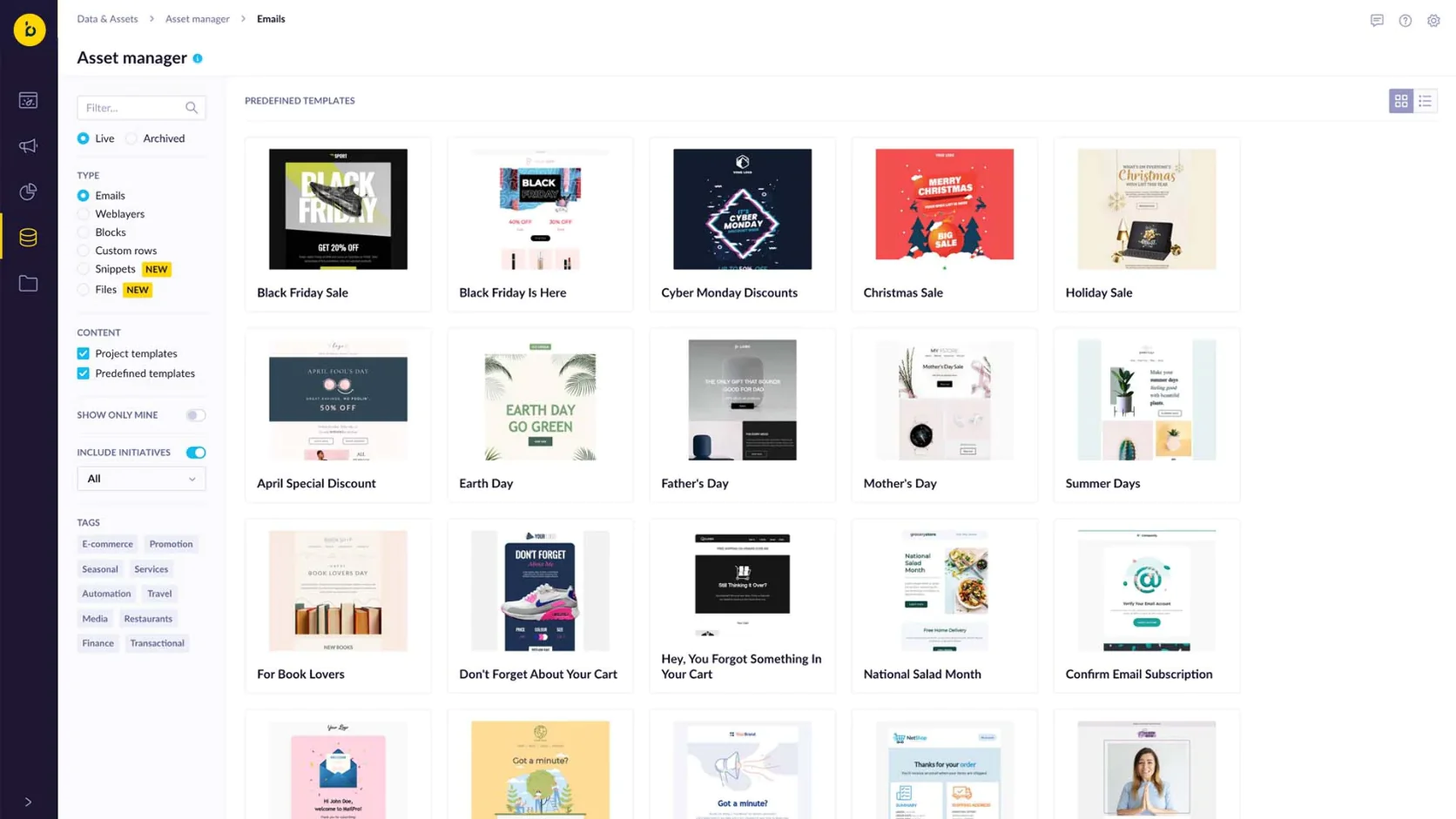
Bloomreach’s asset manager
Many enterprise and mid-market retailers use Bloomreach to orchestrate tailored customer journeys at scale—both online and offline.
Key Features
- AI-Driven Product Search & Merchandising: Combines natural language processing with real-time behavioral data to deliver relevant search results and personalized category pages.
- Content Management: Provides drag-and-drop content editing, layout tools, and personalization rules.
- Omnichannel Engagement: Includes modules for email, push notifications, SMS, and more .
- Analytics & Reporting: Offers performance dashboards, funnel analysis, and customer lifetime value tracking.

Bloomreach’s Performance Overview dashboard
Strengths
- Robust Personalization: Real-time recommendation engine that adjusts to user behavior, combined with a powerful segmentation system.
- Highly Advanced Search: Bloomreach’s search algorithms excel in e-commerce contexts with large product catalogs.
- Enterprise-Grade Scalability: Can handle high traffic and transaction volumes for large retailers.
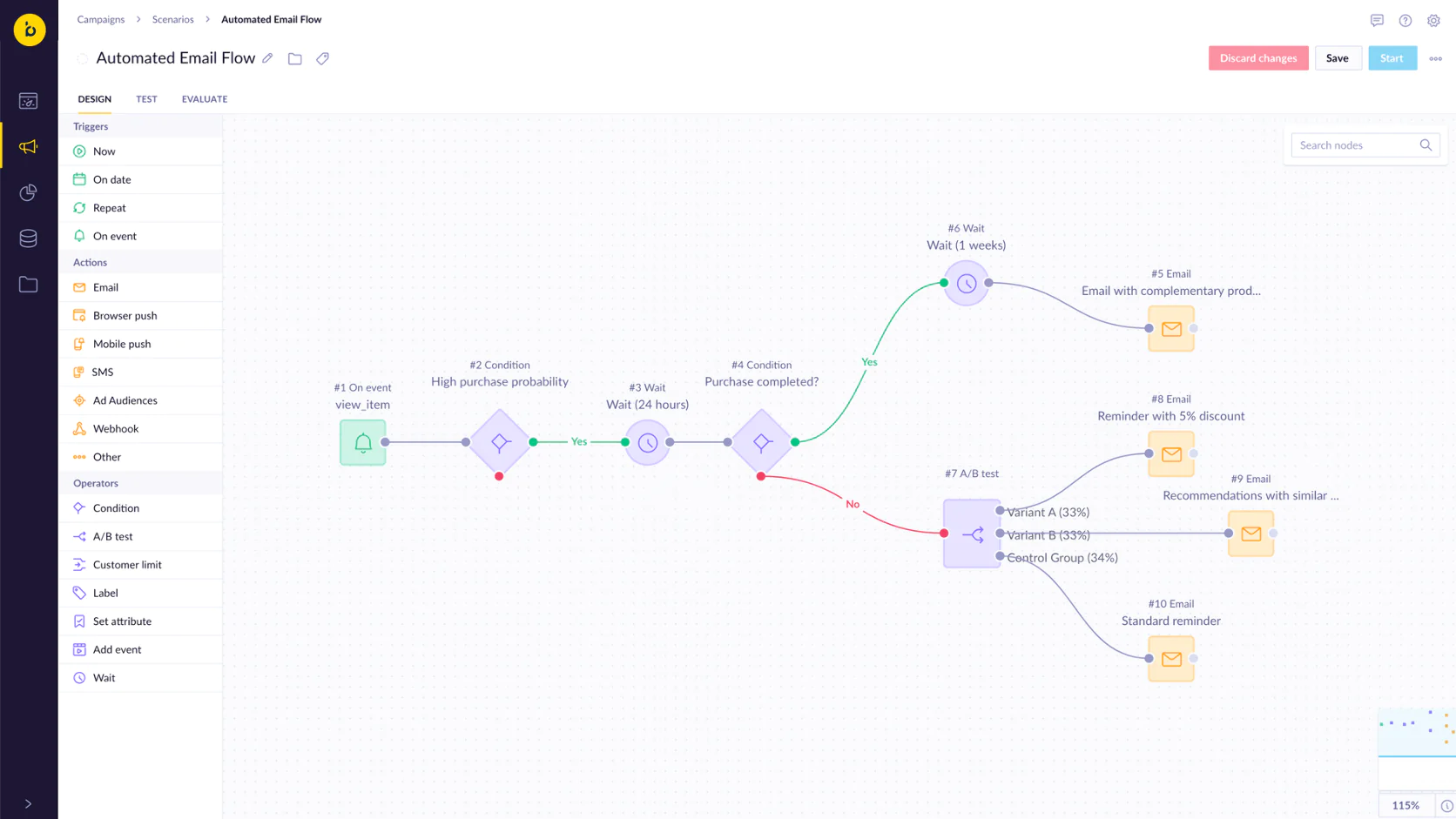
Bloomreach’s flow builder
Weaknesses
- Premium Pricing: Licensing costs are typically higher than many competitors, which can be a barrier for smaller or mid-market brands.
- Technical Complexity: Setup may require more extensive development resources, especially for custom implementations.
- Integration Limitations: Some e-commerce platforms require custom builds or third-party connectors to fully leverage Bloomreach.
- Steep Learning Curve: Marketers often find they need specialized training to master the platform’s advanced features.

The Alternatives at a Glance
Platform
Personalization & AI
Omnichannel Marketing
Maestra
Real-time AI-driven personalization, recommendations & segmentation
Email, SMS, web/mobile push, loyalty programs, on-site personalization, ads integration
Insider
Advanced AI segmentation, predictive personalization & recommendations
Email, SMS, push, in-app messaging, WhatsApp, ads retargeting
SAP Emarsys
Predictive personalization tailored for retail
Email, SMS, mobile apps, social/ads audiences, direct mail, call centers
Klaviyo
Data-driven segmentation, basic predictive analytics
Primarily Email & SMS; basic integration with ads
Adobe (Marketo + Target)
Advanced automation; AI-driven web personalization (Adobe Target)
Email (Marketo), web/app personalization (Target); limited without full stack
Salesforce Marketing Cloud
Einstein AI-powered personalization (email/web); Interaction Studio
Email, SMS, mobile push, ads, social
Braze
Real-time personalization with predictive capabilities
Mobile-centric (push notifications, in-app, email, SMS, web push)
Leading Alternatives to Bloomreach
Maestra—All-in-One Marketing Platform for Midsize Retail
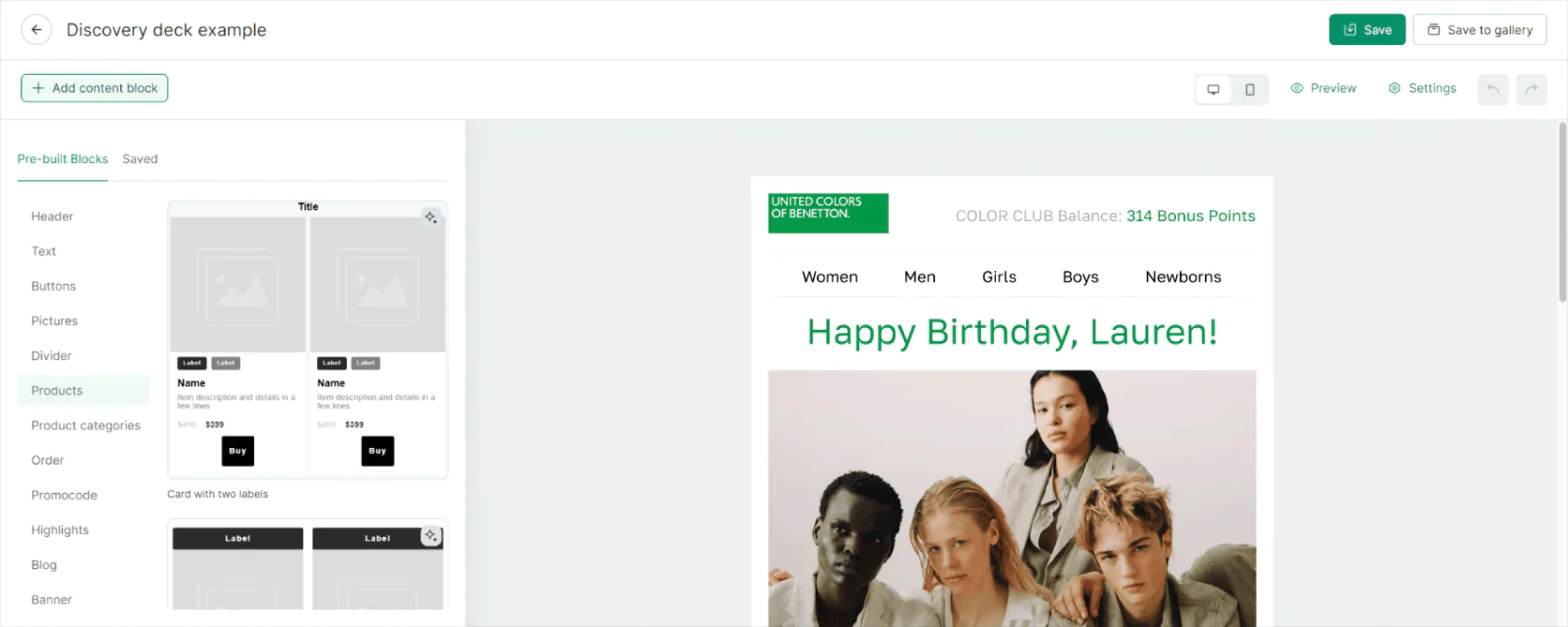
Maestra’s visual email composer
Maestra is a newer entrant designed as an all-in-one marketing automation platform built for midsize retail brands. It combines multiple capabilities—a real-time CDP, omnichannel campaign management, on-site personalization, product recommendations, loyalty program management, and ad audience sync—into one solution. The idea is to give mid-market e-commerce businesses enterprise-like personalization and automation, but with lower cost and complexity. Maestra works in real time and enables brands to run complex omnichannel campaigns and personalized promotions from a single tool.
Personalization & AI: Maestra offers AI-driven personalization across channels. At its core is a real-time CDP that collects all customer data (browsing behavior, purchase history, etc.) into detailed profiles. This fuels its personalization engine.
Enlightened Equipment Achieves 15% Website Conversion Growth with AI-Powered Product Recommendations
On websites, Maestra provides AI-powered site personalization—e.g. dynamic content or product recommendations based on each visitor’s behavior. It also has a product recommendation and merchandising module, suggesting it can automate “People who viewed X also viewed Y” or upsell/cross-sell placements similar to Bloomreach’s recommendation algorithms.
In summary, Maestra brings a strong personalization feature set geared towards driving more revenue per customer through tailored content and offers.
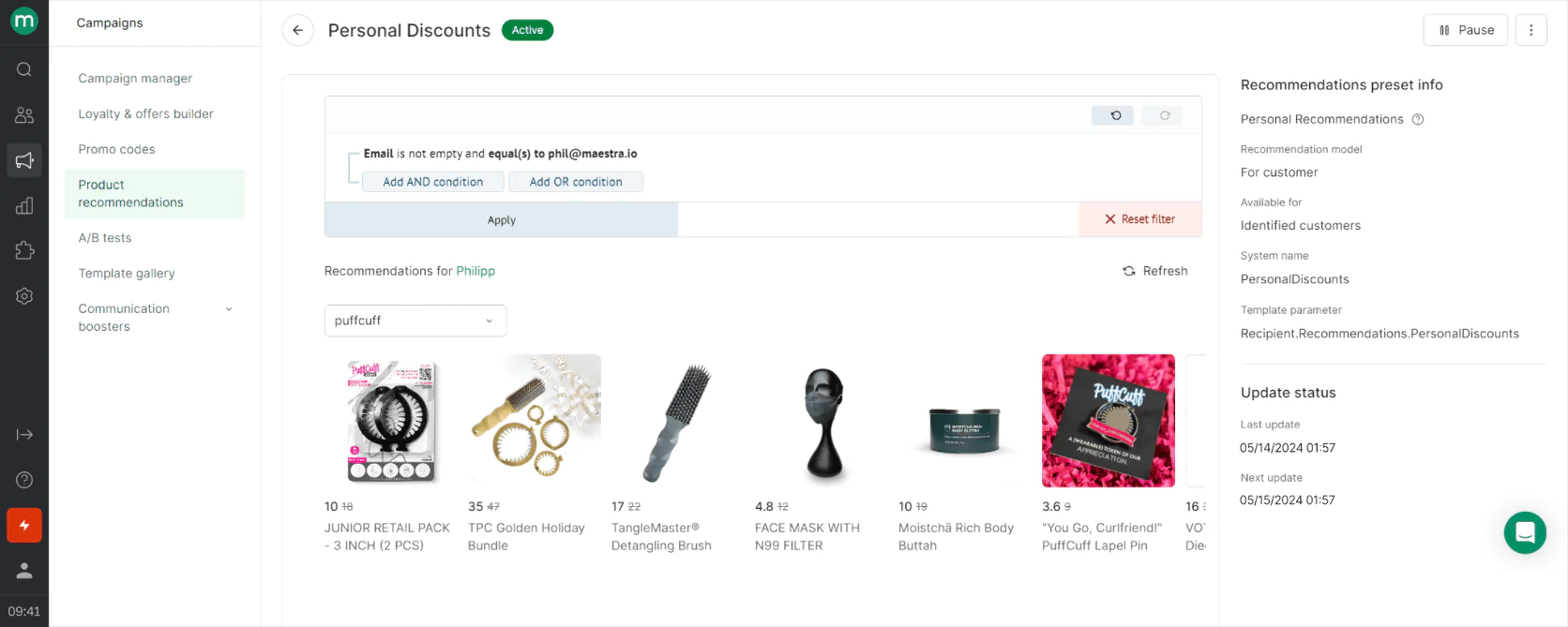
Maestra: сreating a personalized recommendations block
Omnichannel Capabilities: Maestra is the only tool needed to manage the entire customer experience for a retail brand, covering communications and on-site interactions. It supports email marketing, SMS, web push notifications, mobile app push, and on-site personalization.
Uniquely, it also includes a loyalty program module and discount/promotion management built-in. This means you can run a points-based loyalty program and then use those loyalty tiers in your targeting (e.g. send VIP customers a special offer) all within Maestra.
It also integrates with ad platforms for paid media optimization—automatically syncing customer segments to Facebook/Google Ads and even triggering ad campaigns as part of an omnichannel flow. Few platforms offer that out-of-the-box.
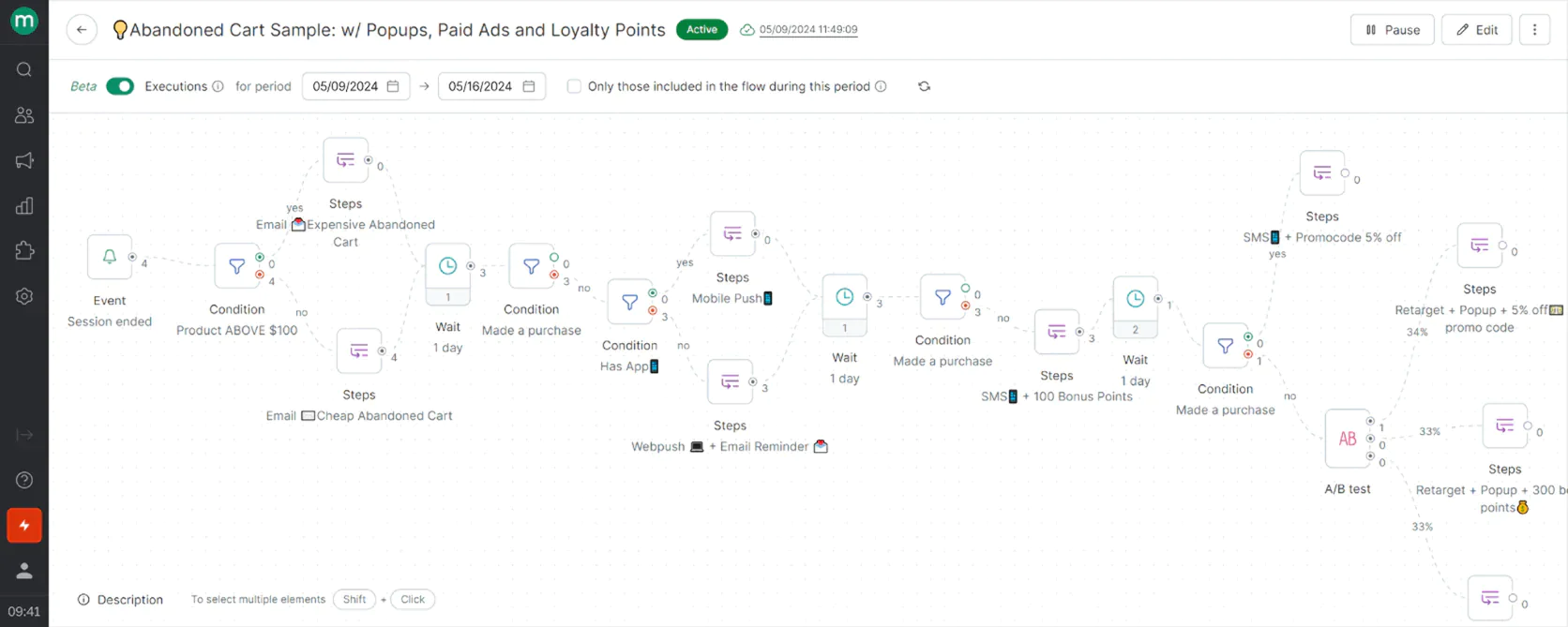
Maestra’s flow example: abandoned card flow with emails, mobile and web pushes, pop-ups, paid ads and loyalty points
Essentially, Maestra’s channel coverage is end-to-end: from sending emails and SMS, to updating on-site content for personalized greetings or product recommendations, to sending a push notification, to showing targeted ads, and even managing loyalty rewards. All these can be orchestrated in unified flows. The architecture is real-time, so customers see updated personalization and triggers immediately as they interact.
This breadth is impressive for a mid-market tool and rivals Bloomreach’s Engagement + Discovery combination in scope.
Scalability & Flexibility: Maestra was built for mid-market scalability—it can comfortably handle databases in the hundreds of thousands of customers and scale beyond. Among their clients is Movavi, a global software company with 70 million users.
One of Maestra’s strengths is flexibility through modularity: it offers 5 key modules—CDP, Multichannel Communications, Loyalty, Website Personalization. Although Maestra tries to be all-in-one, it doesn’t force you to abandon other tools; you can use just its CDP and email, for example, and not use its loyalty module if you already have one. This modular approach and API openness help Maestra fit different needs.
Maestra is primarily focused on B2C retail use cases; its flexibility is greatest in that context. For its target market, it provides a balanced mix of power and adaptability.
Integrations: Being aimed at retailers, Maestra comes with pre-built integrations for popular e-commerce platforms and tools. It natively integrates with Shopify, BigCommerce, WooCommerce, and other storefront systems. This makes data ingestion (products, customers, orders) much easier for those platforms—a big plus for mid-market brands often on Shopify or similar. It also integrates with marketing channels like Instagram and Google Ads (for syncing audiences), and with analytics/BI tools like Tableau and Power BI.
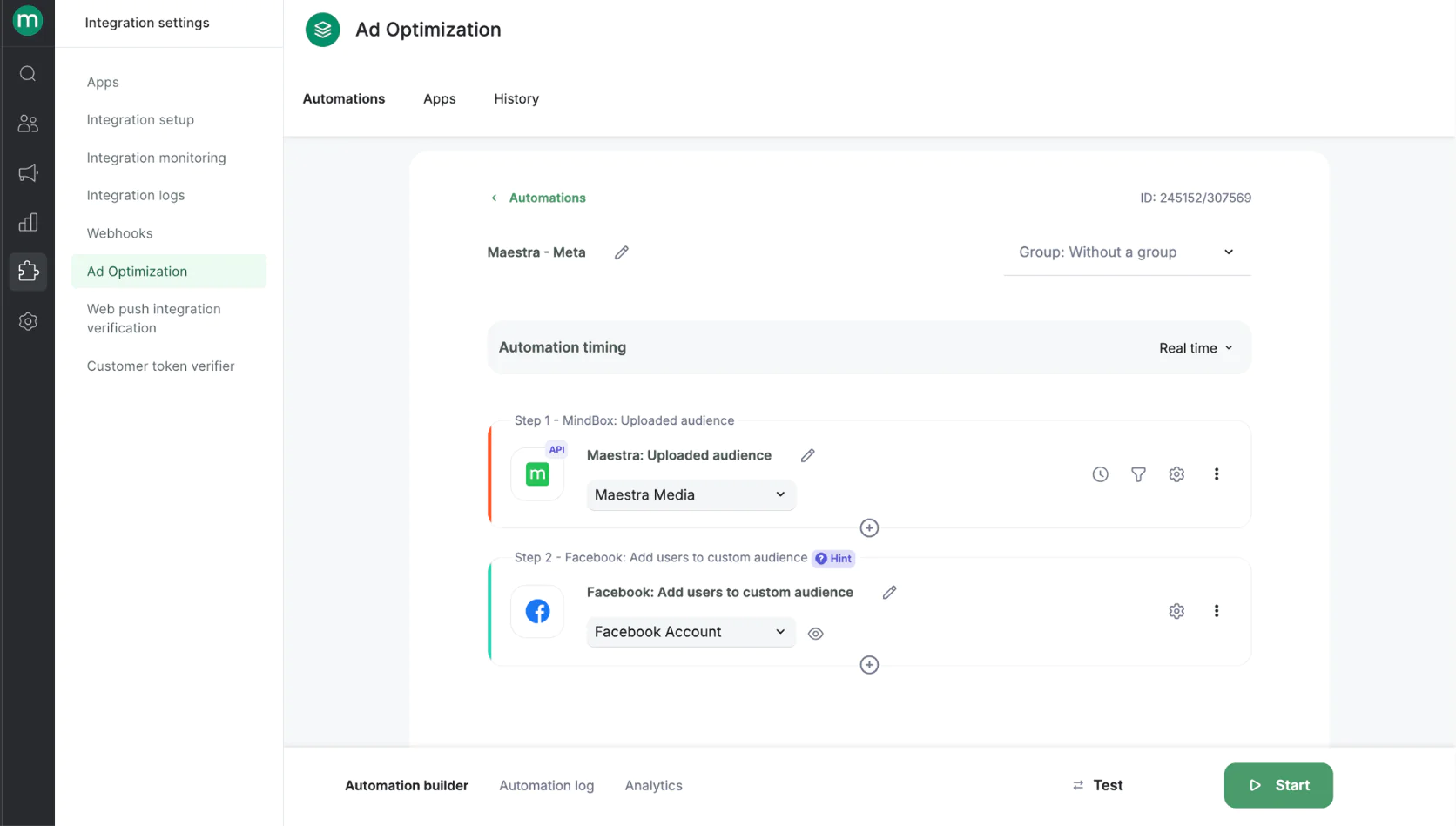
Maestra’s ad optimization tool
Additionally, Maestra’s open API allows hooking in custom data sources or exporting data to data warehouses. While Bloomreach has an API as well, it has been noted to lack some plug-and-play connectors—Maestra’s strategy of delivering ready connectors for commerce platforms can save a lot of integration time and cost.
They also provide custom integration support through APIs and webhooks, assisted by your Customer Success Manager (CSM). So, even if there’s no ready-made connector for something like your unique CMS, Maestra’s team will step in to help you connect it using their APIs or webhooks. Essentially, this means they offer limitless integration possibilities (with developer assistance) for anyone who needs it.
Pricing: Transparent and mid-market friendly. Maestra’s subscription starts at $2,990 per month for up to ~80k customer profiles. This price includes all major features/modules—there are no add-on fees for using additional channels or sending more emails. (Only SMS messages incur a small extra fee, roughly $0.0045 per SMS.) This is a very straightforward pricing model compared to many competitors.
For context, Bloomreach is custom-priced and often significantly more expensive for a similar contact count. Even Klaviyo, while cheaper at small scale, would cost in the mid-hundreds per month for tens of thousands of contacts and still wouldn’t include on-site personalization or loyalty features. Maestra’s pricing includes white-glove support and onboarding as well, which many enterprise vendors charge extra for.
Overall, Maestra aims to deliver enterprise-level functionality at a mid-market price point. For a retailer with, say, 50k-100k customers in their database, paying around $2-4k per month for an all-in-one solution can be very cost-effective compared to stitching together multiple tools or paying enterprise software rates.
User Experience: Maestra is designed to be marketer-friendly and fast to deploy. Users consistently praise its ease of use and smooth onboarding. The interface is described as clean, intuitive, and user-friendly, with straightforward tools for building emails and automation flows that even non-technical users grasp quickly. This is a big differentiator from Bloomreach, which some find not intuitive and requiring more training.
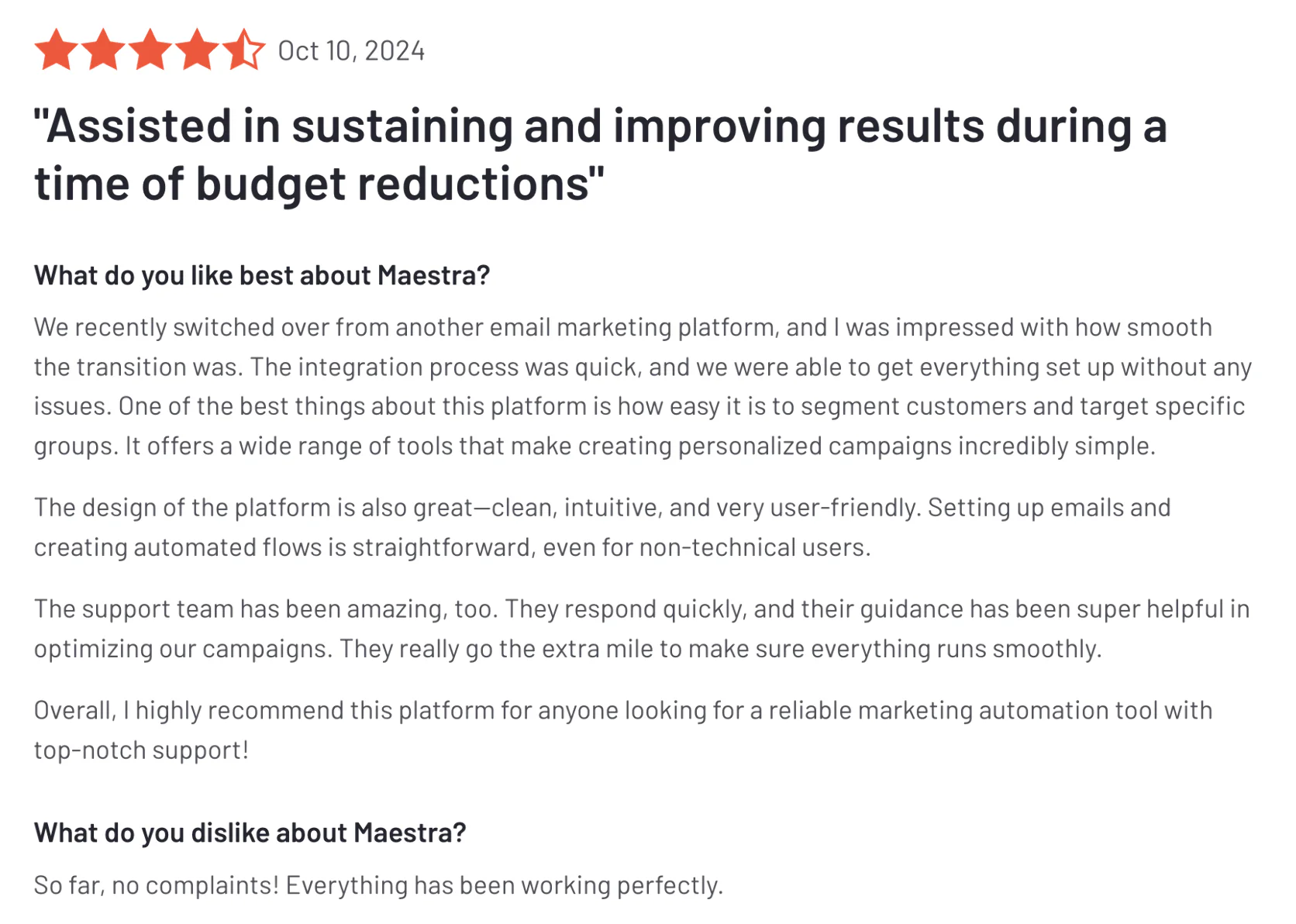
Maestra also provides a dedicated customer success manager to each client and very responsive support. That “white-glove” service means Maestra’s team will actively help set up your initial flows and optimize them—reducing the burden on your team. In G2 reviews, customer support is the top-rated aspect of Maestra, followed by ease of use and ease of integration.
“They are designing, delivering, and managing our customer engagement which is resulting in producing 17% of our monthly sales”
This hands-on support and focus on mid-size business needs result in a shorter learning curve and faster time-to-value.
Compared to Bloomreach: Maestra costs significantly less, integrates more smoothly with popular e-commerce platforms, and offers built-in loyalty features. Bloomreach can deliver more advanced product discovery and search capabilities but at a higher price point and complexity level.
Insider—Cross-Channel Personalization Platform

Insider’s customer profile
Insider is a cross-channel personalization platform that enables seamless, high-converting customer experiences across channels. It addresses data silos by unifying customer data (CDP) and offers AI-driven segmentation and individualized content delivery.
A unique feature is InStory, which lets brands engage users with Instagram-like story content on their sites, and smart segmentation that powers hyper-targeted campaigns.
Personalization & AI: Robust AI-powered personalization engine for web and mobile app content, product recommendations, and predictive audience targeting. Insider’s platform includes smart segmentation (predicting purchase likelihood, churn risk, etc.) to improve relevance.
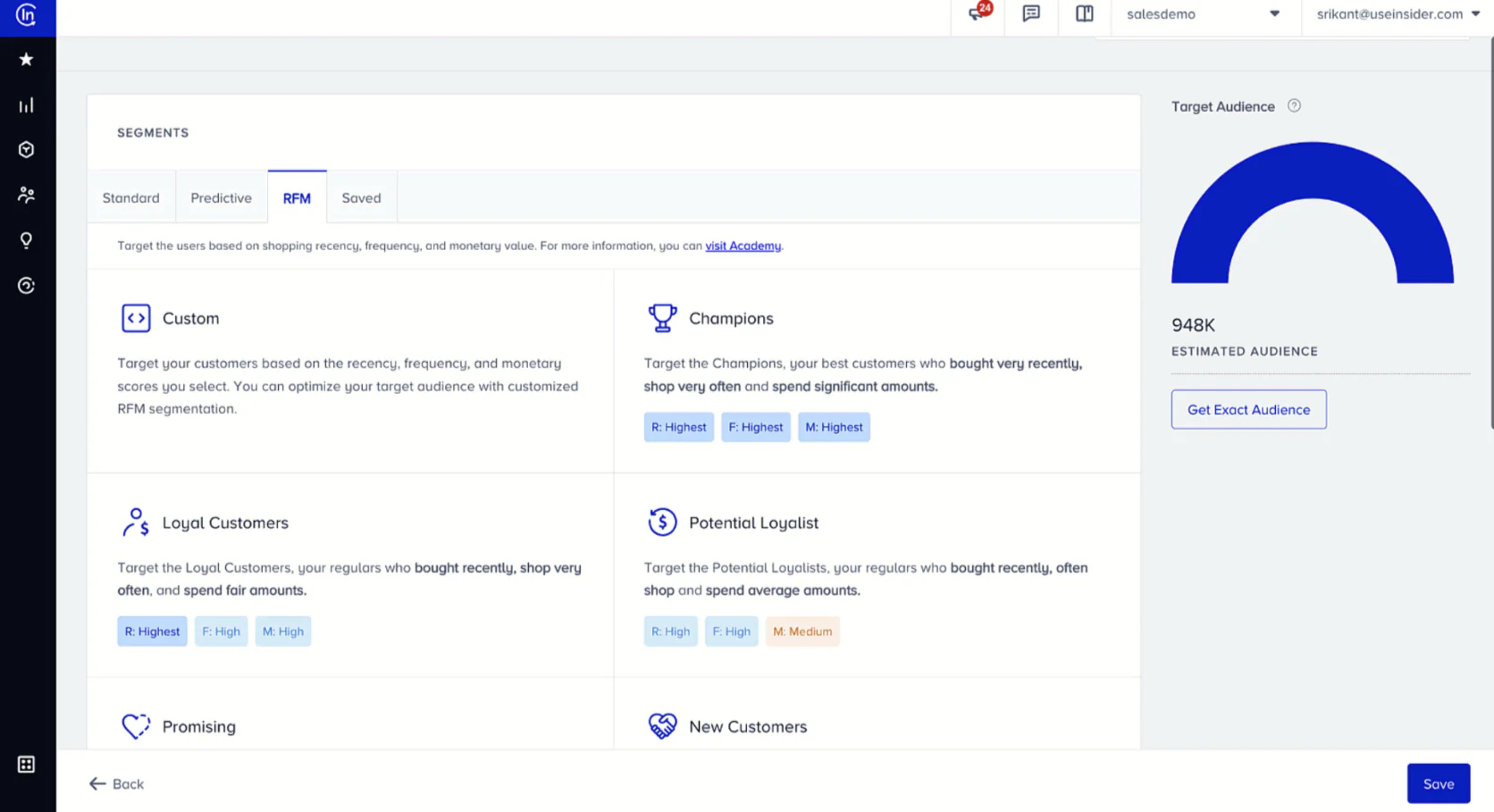
Insider’s segmentation
Omnichannel Capabilities: Supports 12+ channels including email, SMS, push notifications, in-app messages, web personalization, WhatsApp, Facebook Messenger, Instagram DM, and ad retargeting. Marketers can coordinate campaigns across these touchpoints with an intuitive journey builder (the Architect tool) to create cohesive customer journeys.
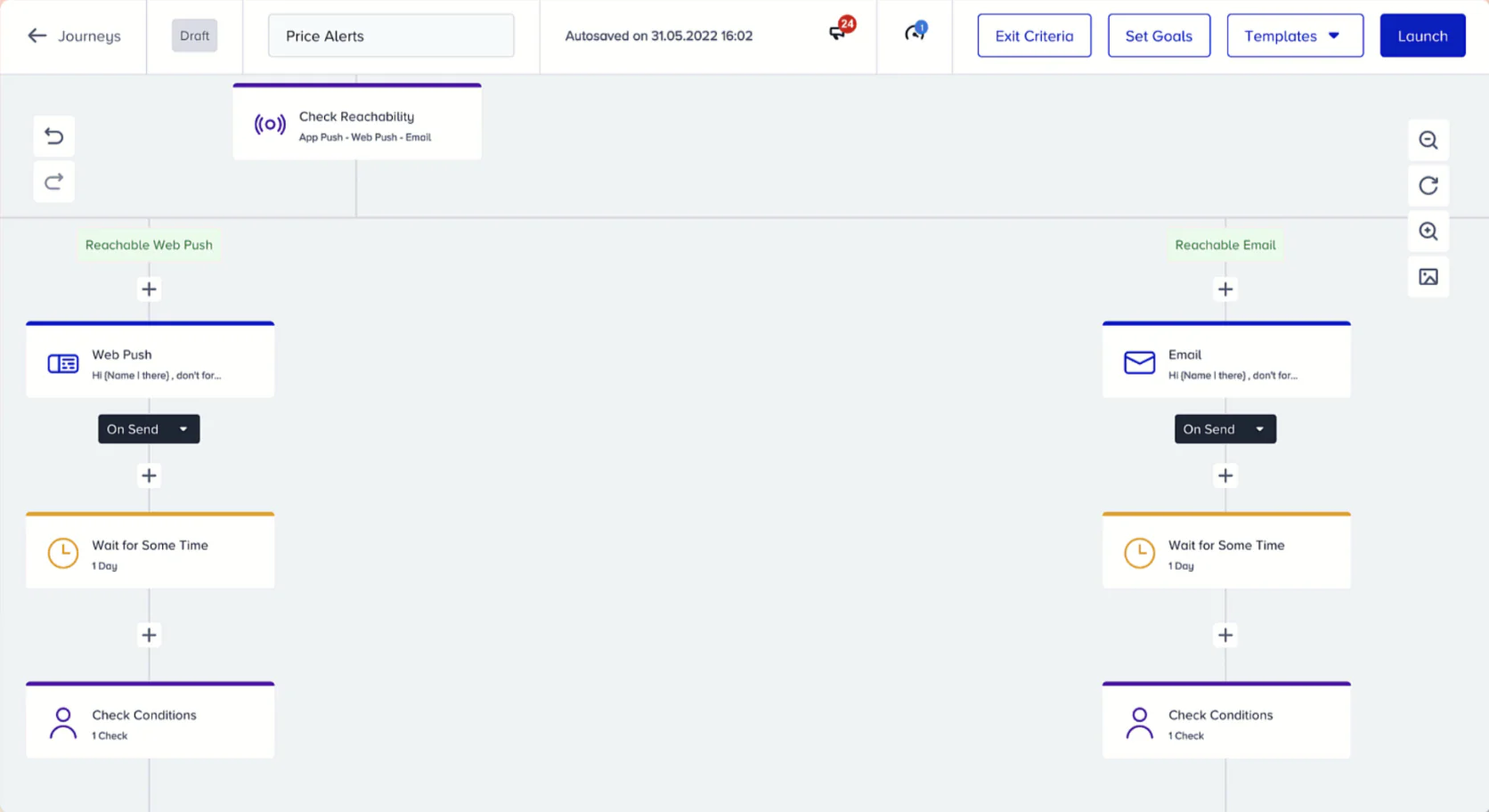
Insider’s flow builder
Scalability & Flexibility: Designed for enterprise scalability—Insider is used by many global retail brands and can handle large volumes of customer data in real time. It offers a flexible API and pre-built connectors to many systems (e.g. Shopify, Magento, Salesforce) to fit into existing stacks.
Integrations: Provides an Integration Hub with out-of-the-box connectors for e-commerce platforms (Shopify, VTEX, etc.), email service providers, analytics tools (Google Analytics, Mixpanel), ad networks (Google, Facebook, TikTok), CRMs and more. This makes it easier to sync customer data and actions between Insider and other tools.
Pricing: Custom enterprise pricing—Insider tailors pricing to the business’s needs (no public price tiers). There is no free tier; it’s generally considered an enterprise/mid-market solution budget-wise.

Insider’s reporting
User Experience: Insider is relatively marketer-friendly for the capabilities it offers. The interface includes templates and a rich library of pre-built campaign journey templates, which helps reduce the learning curve. Insider also prides itself on strong customer support and even hands-on guidance from their success team to accelerate ROI.

Overall, it’s a comprehensive solution if you need a one-stop platform for personalization and multichannel campaign orchestration.
Compared to Bloomreach: Insider emphasizes hyper-personalization across an extensive list of channels (including WhatsApp, Messenger, and push). Bloomreach has an equally powerful AI core but requires more technical overhead and doesn’t natively support some of Insider’s direct messaging channels.
Compared to Maestra: Insider stands out with its strong local partner network and managed services, but it doesn’t include a loyalty module. Maestra is all-in-one with loyalty plus product recommendations in a single subscription.
SAP Emarsys—Omnichannel Customer Engagement for Retail
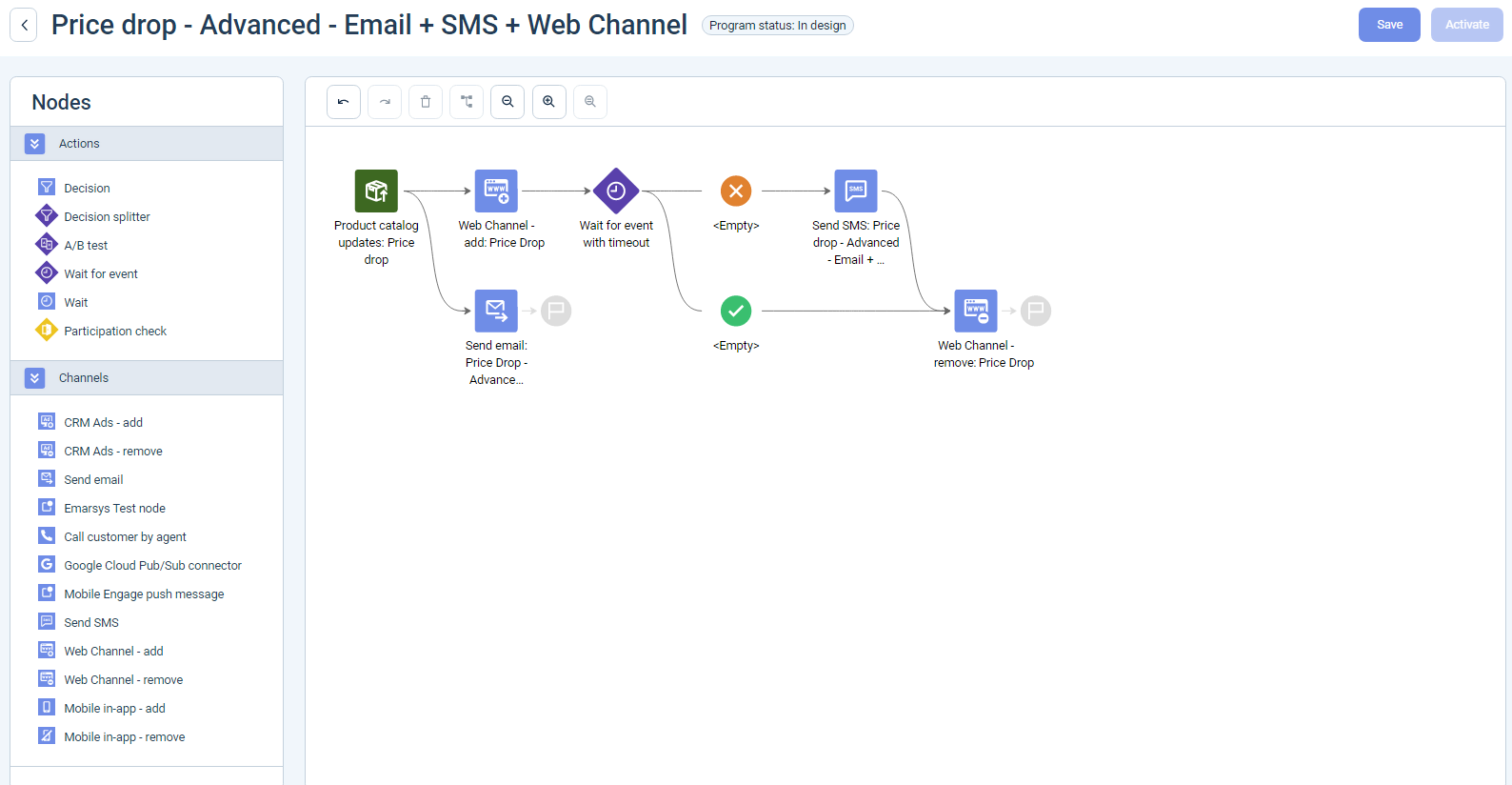
Emarsys’s flow builder
Emarsys (acquired by SAP in 2020) is an omnichannel customer engagement platform tailored for B2C marketers, especially in retail. It combines a real-time CDP, personalization engine, and automated campaign workflows in a single solution. Emarsys excels at helping brands execute data-driven marketing campaigns across channels with a focus on retail outcomes (purchase frequency, lifetime value, etc.).
Personalization & AI: Emarsys offers built-in predictive analytics and personalization features. It can generate product recommendations and personalized content based on customer behavior and lifecycle stage. It also provides industry-specific AI insights (e.g. predicting churn or optimal send times) to optimize campaigns.
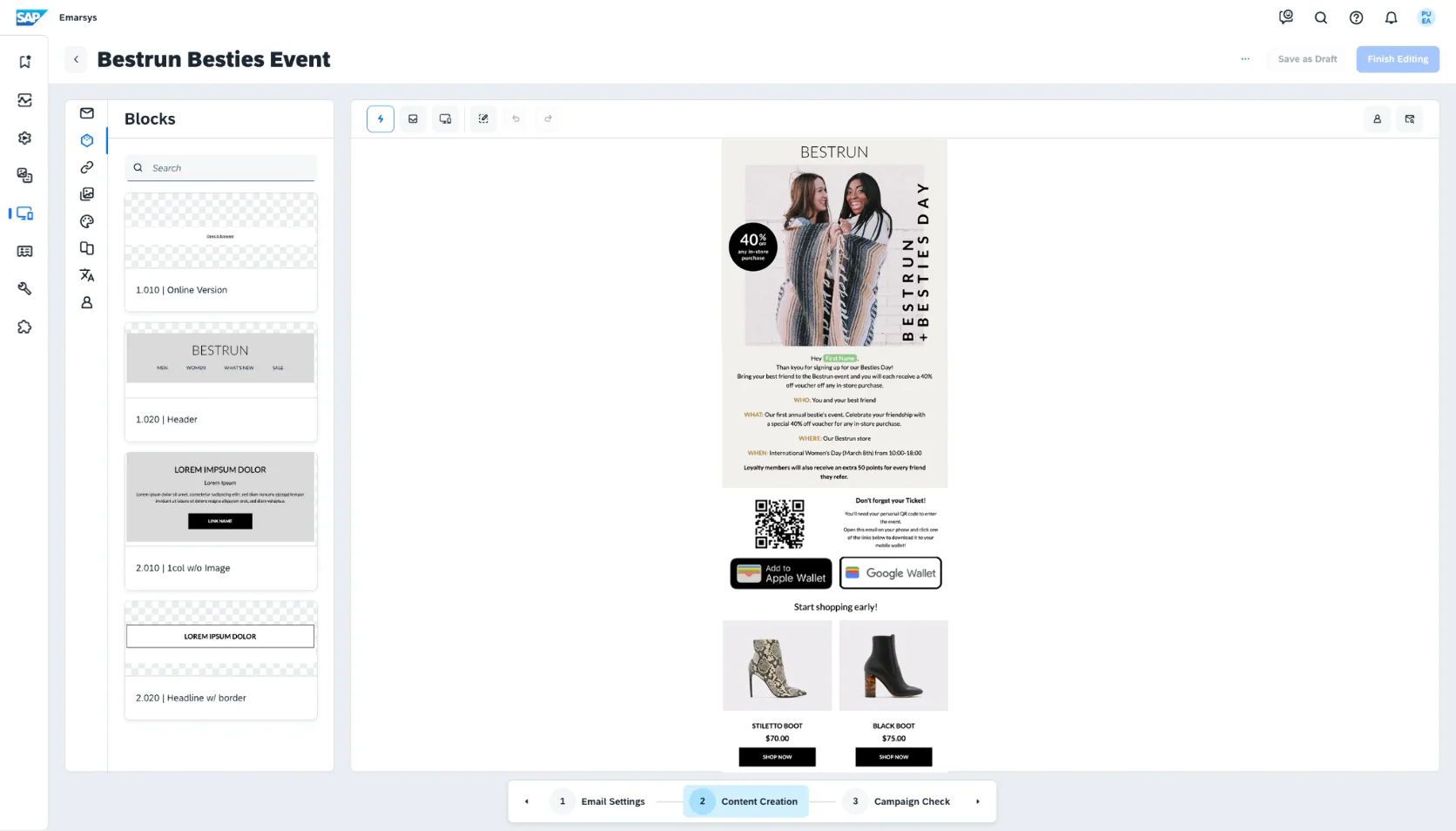
Emarsys’s email editor
Omnichannel Capabilities: Very strong—Emarsys supports email, SMS, on-site personalization, mobile app messaging, digital ads, and even direct mail and call-center integrations. This broad channel support allows true omnichannel campaigns (for example, triggering an SMS or a Facebook Ad audience sync based on email behavior). All channels can be managed and automated from one platform.
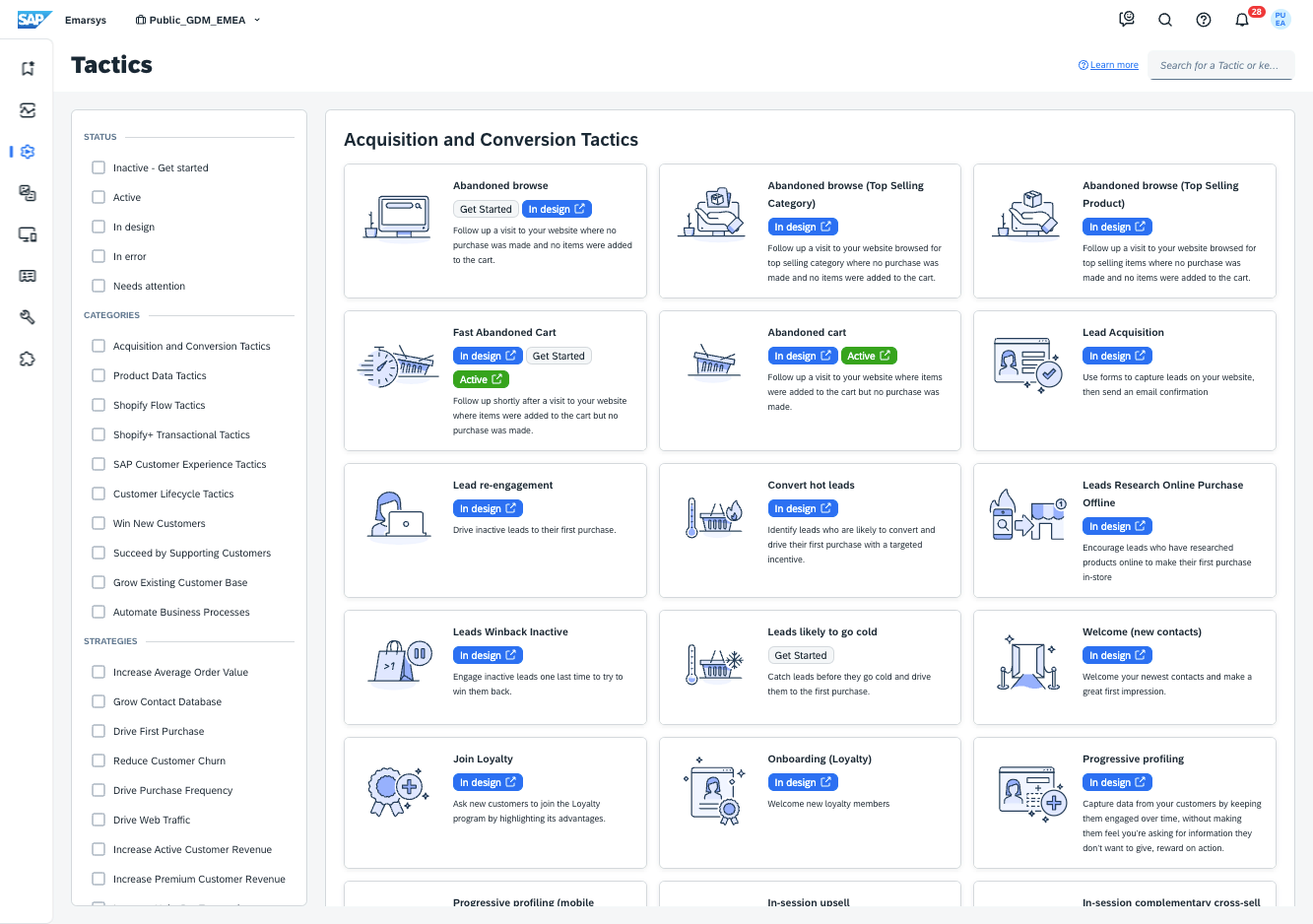
Emarsys’s flow templates
Scalability & Flexibility: As part of SAP’s CX suite, Emarsys is enterprise-grade and scalable for large volumes of data and messages. It’s also used by mid-market brands due to its retail focus. The platform includes a unified data layer (CDP) that gives a 360° customer view, and it’s flexible enough to handle complex segmentation and trigger rules.
Integrations: Emarsys comes with native integrations into SAP Commerce Cloud and other SAP systems. It also provides APIs and some pre-built connectors for popular e-commerce platforms and databases. (For example, clients have integrated Magento, Shopify, and custom web stores with Emarsys.) While not as plug-and-play as some smaller tools, its integration capabilities are solid for enterprise needs.

Emarsys’s reporting
Pricing: Custom pricing (typically in line with mid-market to enterprise budgets). Emarsys doesn’t publish pricing; costs depend on database size and modules used. It’s generally more affordable than Salesforce/Adobe, but pricier than self-service tools.
User Experience: Emarsys is known for a marketer-friendly interface with a drag-and-drop campaign editor and pre-built automation programs for common retail use cases (cart abandonment, post-purchase, reactivation, etc.). Marketers often find it relatively easy to use day-to-day. Onboarding can still take some time (as with any robust platform), but its retail-focused templated approach helps reduce complexity.
Some reviews mention that SAP Emarsys lacks modern features and might feel outdated compared to competitors.

Compared to Bloomreach: Emarsys focuses on retail-centric predictive analytics. Bloomreach is more expansive for content/search but often more expensive to implement. Emarsys offers strong omnichannel features but requires custom integration for certain e-commerce platforms.
Compared to Maestra: Emarsys has pre-build retail automation templates. Maestra, however, tends to be more cost-effective with loyalty and on-site personalization natively included, while Emarsys may need additional modules.
Klaviyo—E-commerce Email & SMS Automation

Klaviyo’s email composer
Klaviyo is a popular marketing automation platform for e-commerce, particularly strong in email and SMS marketing for online stores. It started as an email platform for Shopify merchants and has grown into a broad B2C CRM for mid-market brands. Klaviyo’s sweet spot is direct-to-consumer businesses looking for powerful yet easy-to-use email, SMS, and customer data capabilities without enterprise overhead.
Personalization & AI: Klaviyo specializes in data-driven segmentation and personalized messaging using e-commerce data. It automatically tracks customer behaviors (browsing, purchases) and lets marketers create segments and triggers (e.g. “repeat buyers”, “viewed product X but not purchased”). It also offers some predictive analytics (e.g. expected Customer Lifetime Value, churn risk) which can drive targeted campaigns. Product recommendations are available for emails (based on past purchases or trending items).
However, Klaviyo’s AI features are more basic compared to Bloomreach or Insider—primarily geared toward improving send times and segment predictions rather than complex on-site personalization.
Omnichannel Capabilities: Focused on Email and SMS as primary channels. These are fully built-in and easy to use. Additionally, Klaviyo introduced push notifications (mobile app push) in beta, and it can integrate with Facebook and Google Ads for audience sync (e.g. using Klaviyo segments to create Facebook Custom Audiences for retargeting).
It does not natively handle on-site personalization or in-app messaging—you’d need separate tools for those. Klaviyo is essentially an expert at outbound messaging (email/SMS) and light ad targeting, but not a full omnichannel hub across all touchpoints.
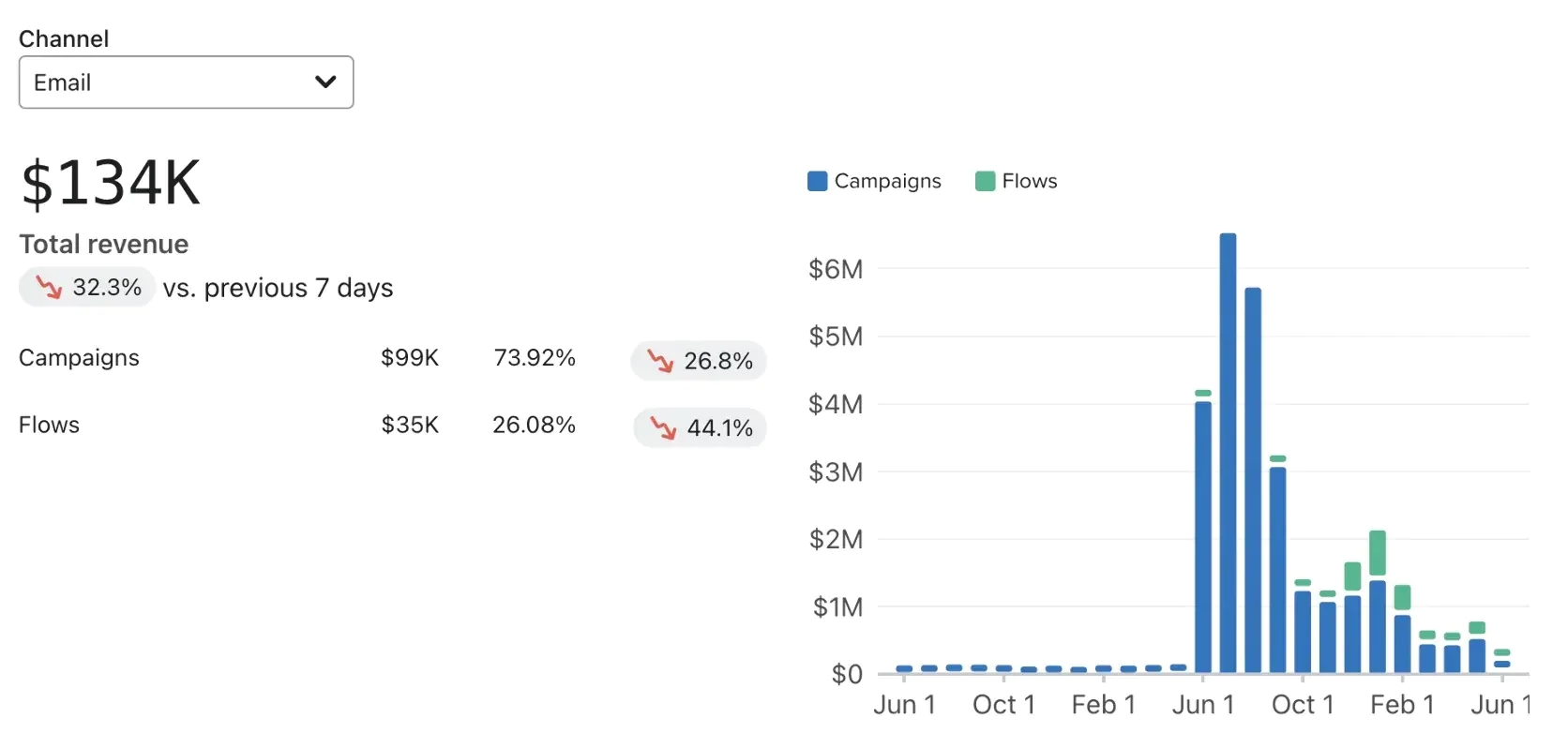
Fragment of Klaviyo’s business review dashboard
Scalability & Flexibility: Very scalable in terms of contact count—it can handle large email lists (many brands send millions of emails via Klaviyo). Its cloud infrastructure scales automatically as your subscriber list grows.
However, flexibility is somewhat limited to its feature set; for example, you can’t run call-center or direct mail campaigns through Klaviyo, and multi-step journeys are mainly oriented around email/SMS. For most mid-sized e-commerce businesses, though, it covers the core needs.
Klaviyo also has an extensive library of pre-built automations (flows) and templates for typical e-commerce scenarios, which adds flexibility and saves time.
Integrations: This is a strong suit. Klaviyo offers plug-and-play integrations with all major e-commerce platforms and tools. It has native integrations for Shopify, BigCommerce, WooCommerce, Magento, Wix, and more—meaning you can sync customer and order data with a few clicks. It also integrates with payment systems, loyalty apps, help desks, and others via built-in connectors or its API. This makes implementing Klaviyo in an existing tech stack relatively easy.
Pricing: Usage-based, affordable for mid-market. Klaviyo has a free plan (up to 250 contacts) and then tiered pricing that scales with the number of contacts/messages. For instance, ~10,000 contacts costs around $150/month, and ~50,000 contacts is about $720/month for email+SMS. All features are included across plans (you’re not charged extra for adding channels or users).
This makes Klaviyo one of the more cost-effective solutions for mid-market businesses—you pay more only as your customer list and sending volume grows. However, smaller businesses may struggle with Klaviyo's pricing, especially after the recent price increase.

User Experience: Excellent ease of use. Klaviyo is often praised for its clean, intuitive interface that marketing teams can pick up quickly. Creating campaigns or automation flows is straightforward with the visual builder, and there’s a shallow learning curve compared to heavy platforms.
In fact, in user ratings, Klaviyo often scores highly for usability but a bit lower on advanced capabilities. Marketers without much technical support can self-service most tasks in Klaviyo, which is a big advantage for resource-strapped teams. (On the flip side, extremely sophisticated multi-channel strategies might be limited by Klaviyo’s simpler approach.)
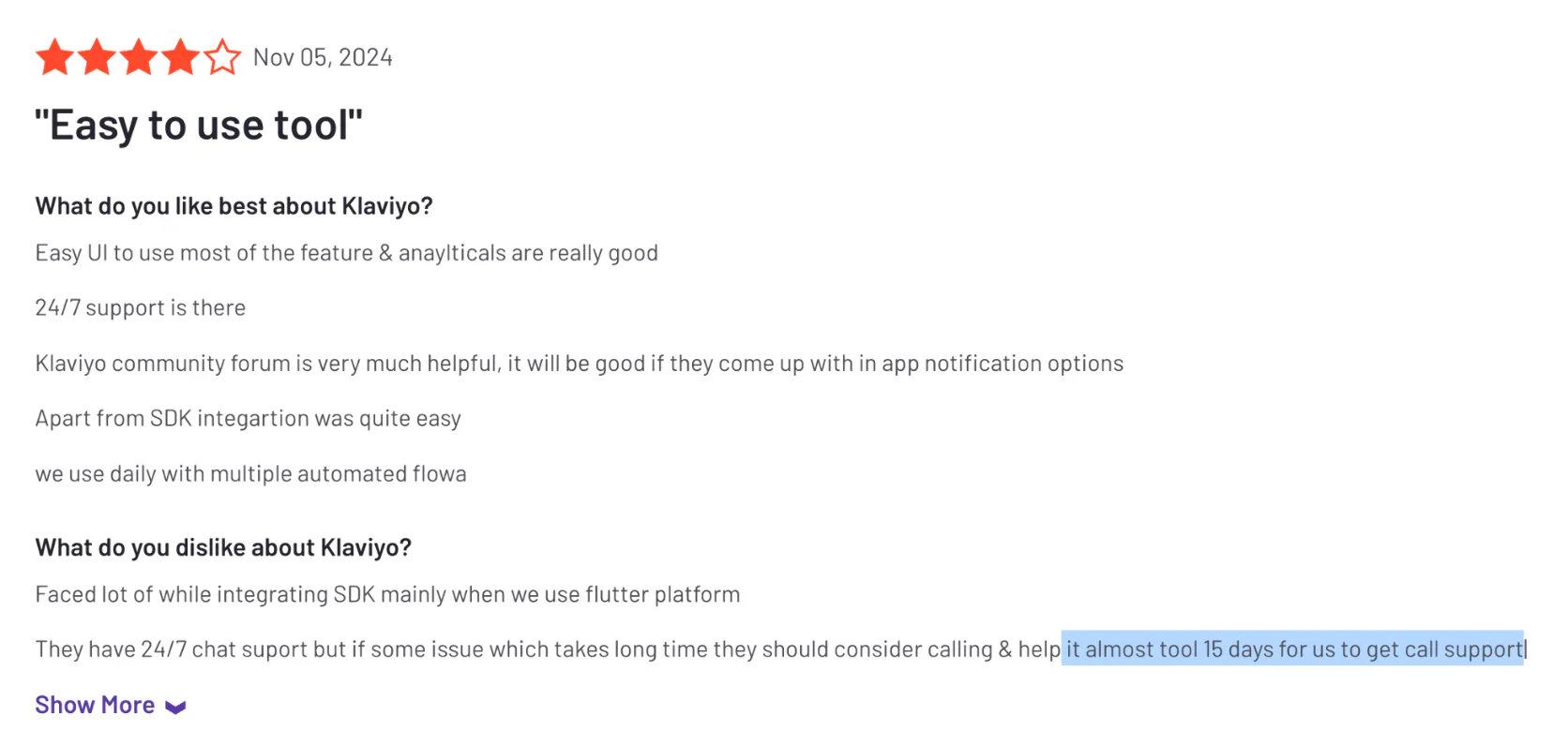
Compared to Bloomreach: Klaviyo is much simpler for email and SMS, but it lacks Bloomreach’s deep on-site personalization and search technology. Bloomreach suits larger enterprise needs, while Klaviyo focuses on straightforward e-commerce marketing.
Compared to Maestra: Klaviyo remains a favorite for small online stores, primarily for email/SMS. Maestra offers broader channel coverage, loyalty management, and on-site personalization, making it more comprehensive for retailers seeking an all-in-one.
Adobe Marketo Engage & Adobe Target—Enterprise Marketing Automation and Personalization
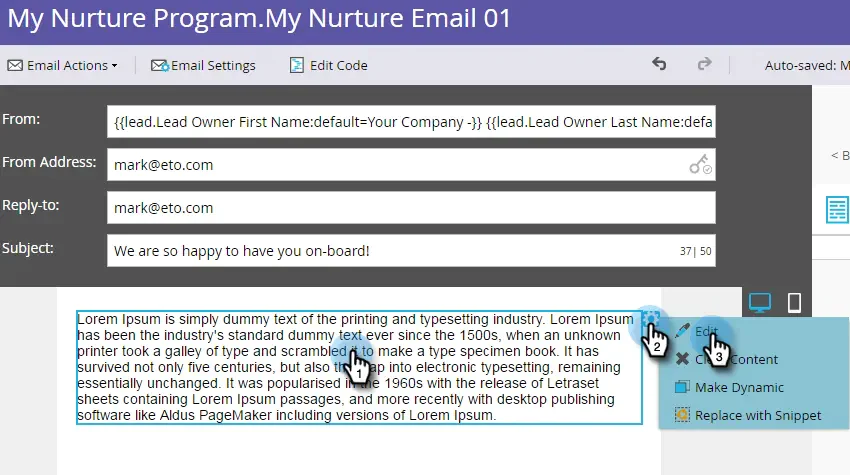
Sending an email via Marketo Engage
Adobe’s marketing stack offers a combination of Marketo Engage (for marketing automation and CRM-driven campaigns) and Adobe Target (for on-site testing and personalization). Together, these (often alongside Adobe Campaign or Experience Cloud) can serve as an alternative to Bloomreach for large enterprises. Marketo and Target are usually deployed in enterprise environments that need robust email marketing, lead nurturing, and website personalization/testing.
Personalization & AI: Marketo Engage provides advanced automation (triggered campaigns, lead scoring, nurture streams) primarily for email and CRM-based marketing. It’s not heavily AI-driven out of the box, though it can personalize email content with dynamic fields and has add-ons for predictive content.
Adobe Target, on the other hand, is an A/B testing and personalization engine for web and mobile experiences. Target uses AI (Adobe Sensei) for features like Auto-Target and Auto-Personalization, which can dynamically serve different content to different audience segments to optimize conversions.
Combined, Marketo+Target cover personalization in emails (Marketo) and on websites/apps (Target) with powerful testing capabilities. However, using them together requires integration effort.

Adobe Target’s Visual Experience Composer
Omnichannel Capabilities: Marketo is strong in email marketing and supports other channels like events and webinars (in B2B contexts). It can do SMS or additional channels, but usually via third-party integrations or LaunchPoint partners.
Adobe Target focuses on web and mobile app channels (e.g. personalized web banners, product recommendations, mobile app content). If an organization implements the full Adobe Experience Cloud, they can cover most channels—e.g. Adobe Campaign for cross-channel messaging, Adobe Journey Optimizer, etc.
As a standalone pairing, Marketo+Target mainly cover email and on-site/app experience. This is sufficient for some enterprise needs (especially those heavily focused on email plus their own site/app), but not as unified for SMS, push, etc., unless augmented by other Adobe tools.
Scalability & Flexibility: Adobe’s solutions are highly scalable for enterprise volumes. Marketo can handle millions of contacts and complex automations (it’s used by Fortune 500 companies). Target can serve personalization on high-traffic sites globally.
They are also very flexible—especially Target, which is quite open-ended (you can create and test almost any kind of experience change). The trade-off is that this flexibility requires more technical and organizational resources. Enterprise teams (or solution partners) are typically needed to fully leverage these tools, and implementation timelines can be lengthy.
Integrations: Both Marketo and Target have extensive integration options. Marketo has a marketplace (LaunchPoint) and integrates well with CRMs (particularly Salesforce), webinar platforms, analytics, etc. For e-commerce platforms: Marketo can integrate with Magento (Adobe Commerce) fairly well (especially since they’re under Adobe now) and with others via APIs. Adobe Target can integrate with any website via inserting its script; it also integrates with Adobe Analytics for deep data sharing.
If you are on the Adobe ecosystem (AEM for CMS, Adobe Analytics, etc.), these tools integrate seamlessly. If not, expect some custom work to connect data and events from your e-commerce store to Marketo/Target.
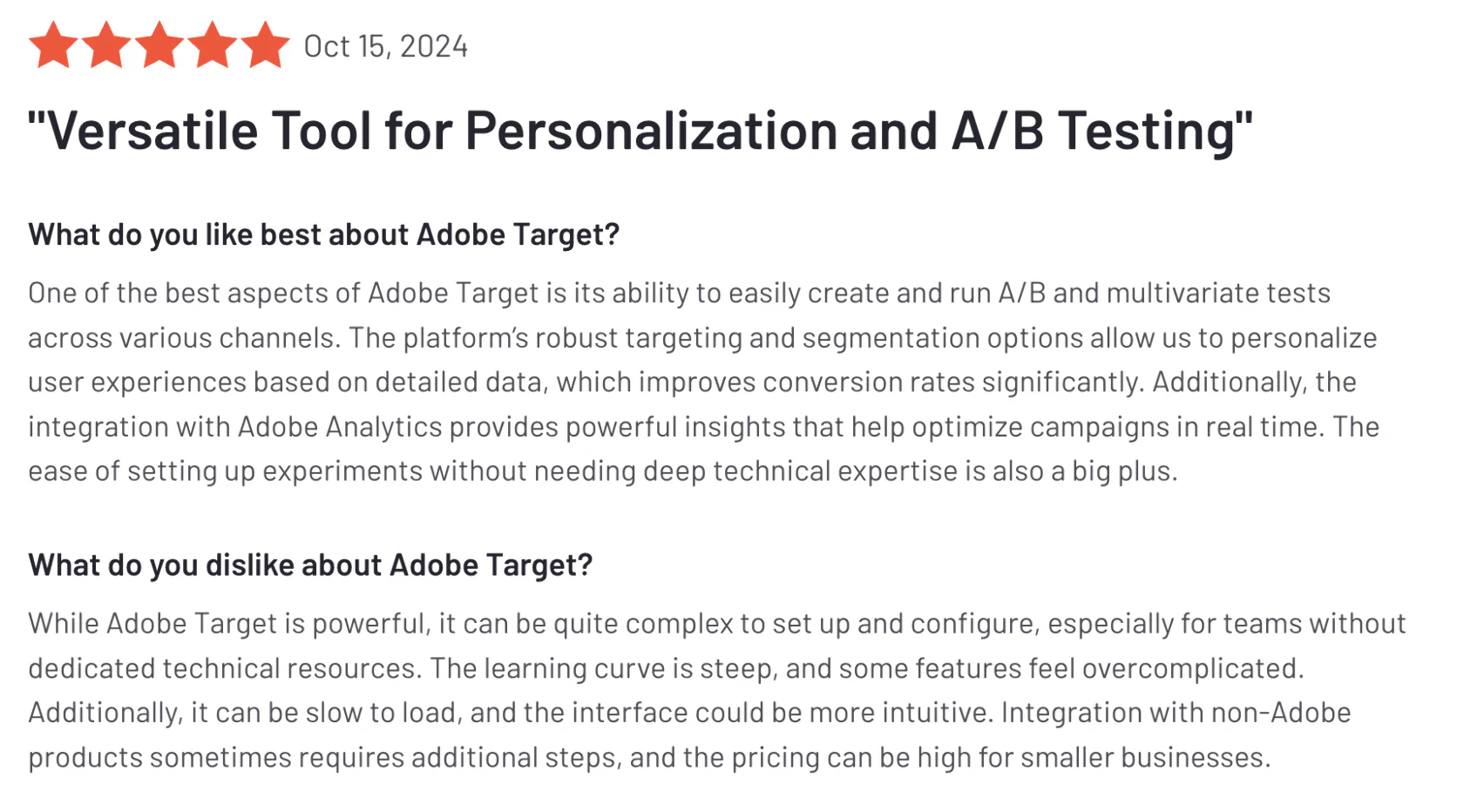
Pricing: Expensive, enterprise-level. Adobe does customized pricing, often bundling multiple products. Marketo Engage is typically sold as tiered packages based on database size (and it can easily run into tens or hundreds of thousands of dollars annually for large databases). Adobe Target is also enterprise-priced (often based on traffic volumes or as part of Adobe Experience Cloud license).
In short, this combo is one of the priciest alternatives—usually justified only for larger enterprises that can maximize the wide capabilities. Mid-market companies often find the cost hard to justify unless they have very ambitious marketing requirements and technical support.
User Experience: Steep learning curve. Users often report that Marketo’s interface, while powerful, is not the most intuitive for beginners and requires training to use effectively. Adobe Target typically requires involvement from developers or technical marketers to set up tests and personalization campaigns. In other words, these tools are not “turnkey”—they demand significant expertise.
Skilled teams can do very advanced marketing with Adobe. It provides documentation and there’s a large community, but expect to invest in enablement. For an organization that already uses multiple Adobe products, the integration and familiarity can improve the experience, but for others, this stack can feel overwhelming compared to more out-of-the-box platforms.
Compared to Bloomreach: Adobe’s suite matches Bloomreach on enterprise-grade personalization, especially with Target’s testing. However, Bloomreach’s commerce-focused functionality is more turnkey, whereas Adobe typically requires significant customization.
Compared to Maestra: Adobe offers deep integrations within its ecosystem. Maestra is more streamlined and cheaper to implement, particularly for mid-market retailers.
Salesforce Marketing Cloud—Data-First Enterprise Marketing Suite

Salesforce Marketing Cloud’s email builder
Salesforce Marketing Cloud (SFMC) is a data-driven digital marketing suite widely used by large B2C brands for cross-channel customer engagement. It encompasses various “Studios” and “Builders” (Email Studio, Mobile Studio, Social Studio, Advertising, Journey Builder, etc.) to manage campaigns across email, mobile, social, and beyond. SFMC, combined with Salesforce’s CRM and Commerce systems, can serve as a comprehensive alternative to Bloomreach Engagement for big retail enterprises.
Personalization & AI: SFMC leverages Salesforce’s Einstein AI for features like predictive scoring, product recommendations, and automated insights. For instance, Einstein can predict engagement (who is likely to open/click), recommend send times for each user, or even auto-select the best content variant.
There’s also Interaction Studio (now Salesforce Marketing Cloud Personalization, originally Evergage) which provides real-time web personalization and product recommendations similar to Bloomreach’s on-site personalization. With these, Salesforce offers very advanced personalization capabilities, from tailored emails to dynamically personalized web pages.
It’s worth noting you often need to add modules (and data integration) to fully match Bloomreach’s breadth—e.g. SFMC by itself handles messaging and some predictive analytics, but adding Interaction Studio gives you that on-site personalization piece.
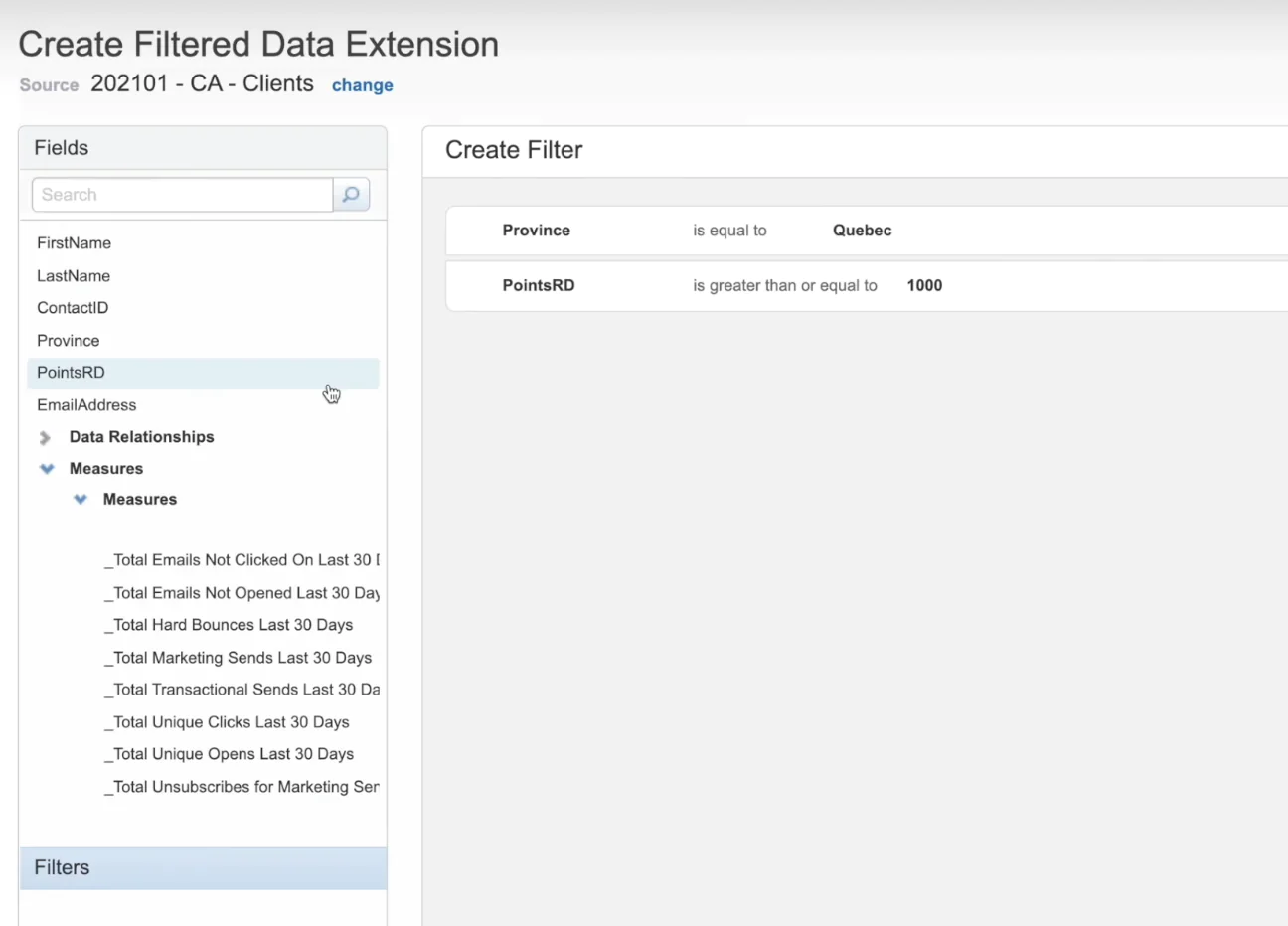
Salesforce Marketing Cloud: user segmentation
Omnichannel Capabilities: Excellent—SFMC is designed for omnichannel marketing. Out of the box it covers Email, SMS, MMS, push notifications, and integrates social channels (both organic and paid social advertising).
- Journey Builder allows creating customer journeys that span these channels (for example: send an email, then an SMS reminder, then add to Facebook Audience if no response, etc.).
- SFMC’s Advertising Studio lets you manage ads/retargeting audiences.
- With Social Studio, you can manage social media engagement and listening.
Essentially, SFMC aims to be the one hub for all digital communications. One gap: for on-site content personalization or A/B testing, Salesforce has separate products (Interaction Studio, Salesforce CMS, etc.), so those aren’t in the core SFMC by default.
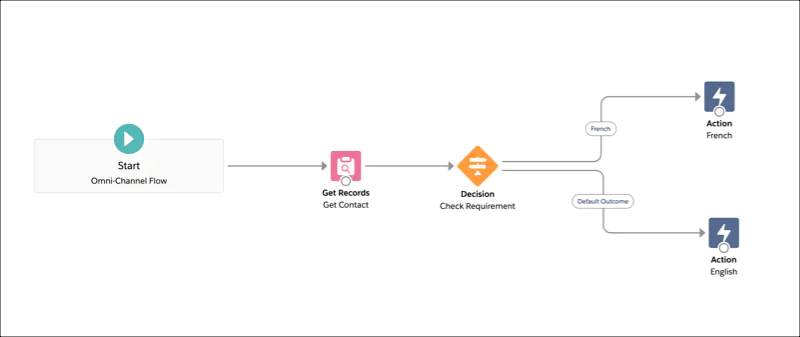
Salesforce Marketing Cloud flow builder
Scalability & Flexibility: SFMC is highly scalable. It’s used by some of the largest retailers, banks, and travel companies to send billions of messages. The underlying infrastructure (now on Salesforce Hyperforce cloud) handles huge data volumes and throughput.
Flexibility is a double-edged sword: you can craft very complex, tailored solutions with SFMC given its many studios and builder tools, but this also means complexity. It’s flexible in integrating data (with a built-in CDP/unified profile store) and in defining custom journeys. Most enterprises will find it flexible enough to accommodate their marketing strategies—the question is whether they have the resources to take advantage of that flexibility.
Integrations: As expected, SFMC integrates best with Salesforce’s own ecosystem—Sales Cloud (CRM), Service Cloud, Commerce Cloud, etc., allowing 360° data sharing. For example, a retailer on Salesforce Commerce can plug in product and transaction data fairly easily to SFMC.
Integration with third-party e-commerce platforms (like Shopify, Magento) is not as straightforward, often requiring custom API work or middleware, since Salesforce positions its own commerce platform. SFMC does have APIs and some connectors, but integration can be a project, especially for real-time data sync. Many companies use integration tools or ETL processes to feed data into SFMC’s data extensions if they’re not on Salesforce CRM.
In summary, integration is robust but not plug-and-play unless you’re within the Salesforce family.
Pricing: High-end and modular. Salesforce Marketing Cloud is known for its complex, premium pricing. You typically purchase a tier (Basic, Pro, Corporate, Enterprise editions) which have contact and feature limits, and then possibly add extra modules (Messaging costs, additional Studios, etc.). Costs can easily run into six or seven figures annually for large implementations.

In short, SFMC is usually one of the most expensive options, suitable when a business is ready to invest heavily in marketing tech.
User Experience: Resource-intensive. Users often note that SFMC is powerful but not very intuitive for new marketers. The interface is split into different studios which can feel siloed (Email Studio vs Mobile vs Journey Builder each has its own UI quirks). Setting up a sophisticated journey might require SQL queries, AmpScript coding (for personalization in emails), and an understanding of data extensions—all of which raise the skill required.
Many companies work with certified SFMC consultants or partners to implement and manage it. Once configured, day-to-day tasks like building an email or SMS campaign are manageable through wizards and content builders. Salesforce has been improving usability (and their Trailhead trainings help), but compared to easier tools (like Klaviyo or even Bloomreach’s UI), SFMC demands a dedicated, trained team to fully leverage.
Compared to Bloomreach: Salesforce Marketing Cloud can rival Bloomreach in AI-driven personalization if combined with Interaction Studio. Bloomreach’s advantage lies in its specialized on-site product discovery and merchandizing capabilities.
Compared to Maestra: Salesforce is a broad, modular platform covering most enterprise needs, but it’s typically very expensive and demands dedicated expertise. Maestra delivers a unified suite at a lower price point and with faster onboarding.
Braze—Real-Time Customer Engagement (Mobile-Centric)
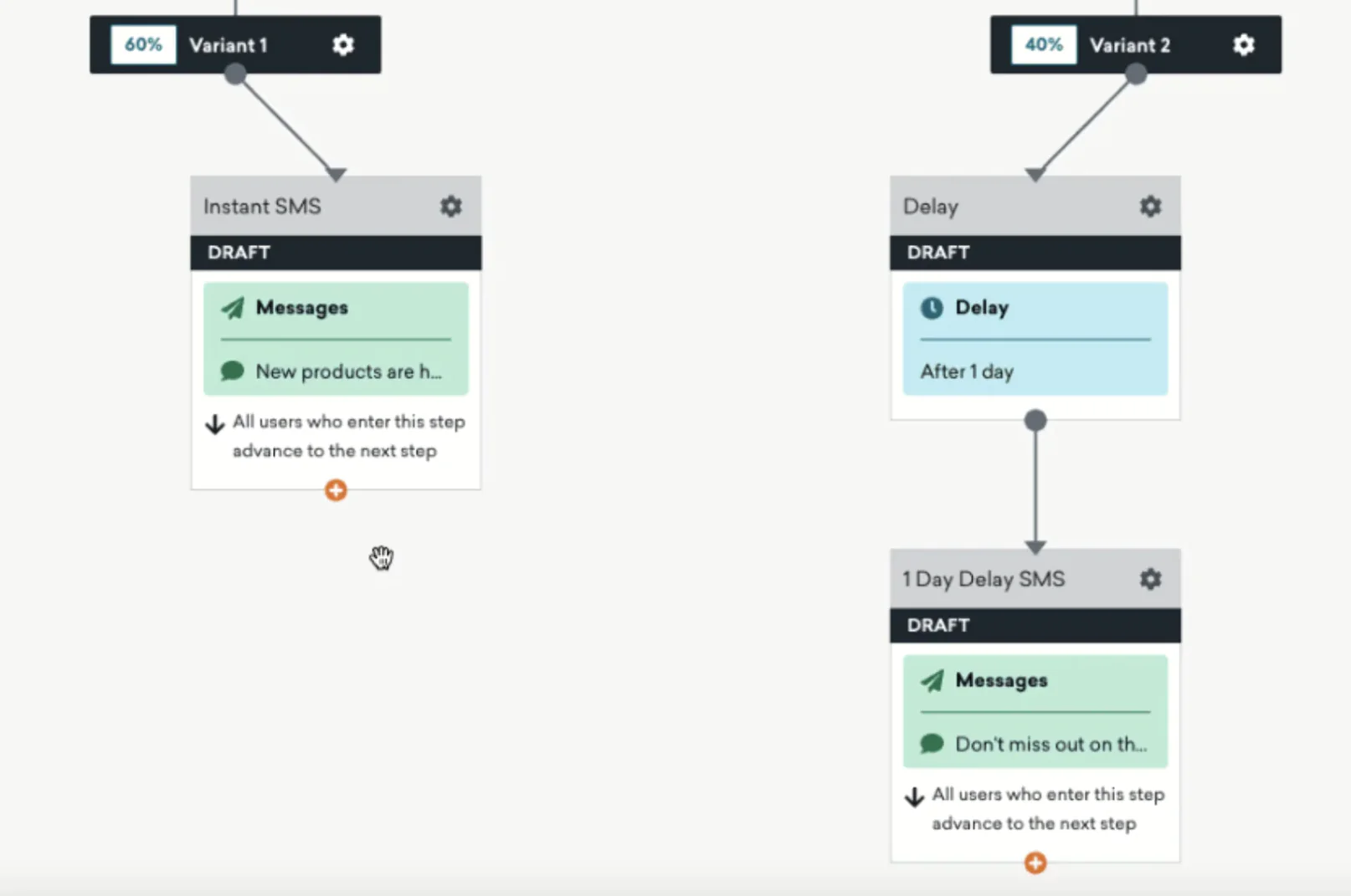
Braze’s Canvas tool
Braze is a customer engagement platform known for its strength in real-time mobile and multichannel marketing. It’s used by many consumer brands (including retailers, media, and fintech) to deliver coordinated messages across mobile apps, websites, and email. If your e-commerce business has a significant mobile app audience or you need instantaneous personalization, Braze can be a compelling alternative to Bloomreach’s engagement module.
Personalization & AI: Braze focuses on real-time personalization—it reacts to user behaviors (like app actions or web events) in seconds to trigger messages. It supports personalized content insertion, and with its Intelligence Suite, marketers can leverage predictive tools (for example, predicting churn or optimal send time).
Braze doesn’t inherently provide product catalog recommendations out-of-the-box as a feature like Bloomreach does, but it can ingest recommendation data from other systems or use machine learning with Currents (their data streaming) to personalize messaging.
Braze’s personalization is very strong for messaging (dynamic content, user attributes) and slightly less about on-site product discovery.
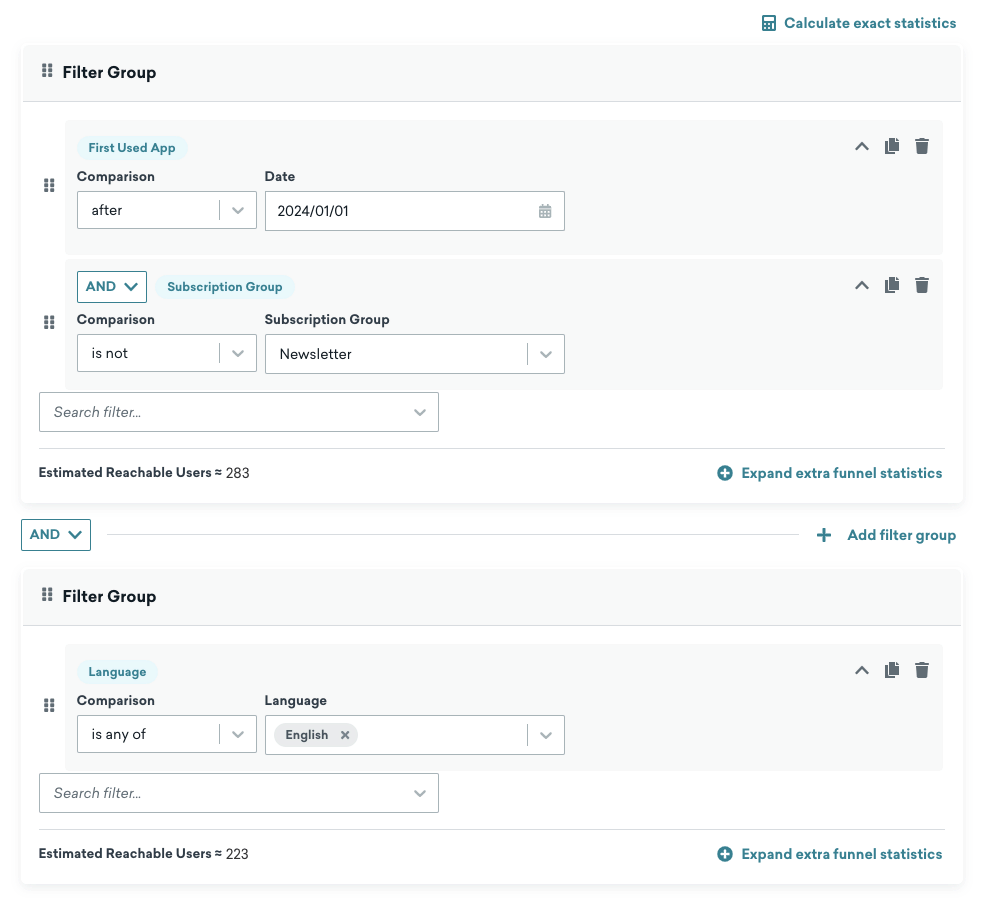
Creating a segment in Braze
Omnichannel Capabilities: Braze covers mobile and web channels deeply. It originated as a mobile-first platform (formerly Appboy), so it excels at push notifications, in-app messages, and even in-app content widgets (Content Cards). It also has email and SMS capabilities, plus web push and webhooks (to integrate with other channels like WhatsApp via third parties). Using Braze, a retailer can orchestrate a campaign that, say, sends a push notification when a user leaves items in cart on the app, follows up with an email, and shows an in-app message with a discount next time they open the app.
One thing Braze doesn’t do is on-site web personalization in the sense of changing the website’s content; it focuses on messaging channels. So for web personalization, you’d pair it with a testing tool or just use its embedded Content Cards.
Overall, it’s omnichannel with an emphasis on mobile/app + messaging touchpoints.
Scalability & Flexibility: Braze is built to scale to enterprise needs—it handles huge volumes of events and messages (their clients include large streaming services and retailers with tens of millions of users). It’s highly flexible in defining triggers and segmentation—developers can stream data into Braze in real time, and marketers can then create very granular segments and triggers.
The system’s architecture is quite modern (real-time streaming), which is a plus for flexibility and speed. However, taking full advantage often means having developers set up the SDKs and data flows properly. For purely email-centric use cases, Braze might be overkill, but for multi-channel real-time engagement, it shines.
Integrations: Braze provides SDKs for mobile and web to capture user events and attributes. It also has an API and supports data export/import via Braze Currents and partnerships (for analytics, data warehouses, etc.). Integration with e-commerce platforms isn’t one-click like Klaviyo—rather, you instrument your app or site to send events to Braze.
Many companies integrate Braze with their data pipeline or CDP (sending ecommerce events like purchases into Braze in real time). Braze also has pre-built connectors with tools like Segment, mParticle, and customer data platforms, making it easier to integrate if you already use those.
Overall, integration is developer-driven but well-documented. If you have a mature data stack, Braze will slot in; if not, you might lean on their professional services or solutions partners to connect all the dots.
Pricing: Premium (custom quoted). Braze is generally considered an enterprise-grade platform, and its pricing reflects that. There are no public prices; it’s quoted based on monthly active users and message volumes. For mid-market, Braze can be pricey unless your focus is heavily on mobile engagement where Braze’s value is highest.
However, some growing D2C brands do use Braze as they scale, indicating it’s not exclusively for Fortune 500—it has packages that can start in the low tens of thousands per year and scale up. It won’t be as cheap as Klaviyo or others, but for what it offers (especially if you need rich mobile push capabilities), many find the ROI worth it.
User Experience: Braze offers a modern UI and is well-liked by marketers who have used it, but initial setup requires technical work. Once the data flows are in place, building campaigns and segments in Braze is fairly straightforward with a drag-and-drop Canvas for journeys. Marketers can visualize multi-step journeys similar to Journey Builder or Architect tools. Braze also has a library of playbooks for common campaigns to help users get started.
The learning curve is moderate—easier than heavy enterprise suites, but a bit more complex than self-serve email tools. One notable aspect is Braze’s documentation and customer success are often praised; they assist clients in learning best practices. So while you might need a developer to get things set up, your marketing team should be able to operate Braze day-to-day after onboarding.
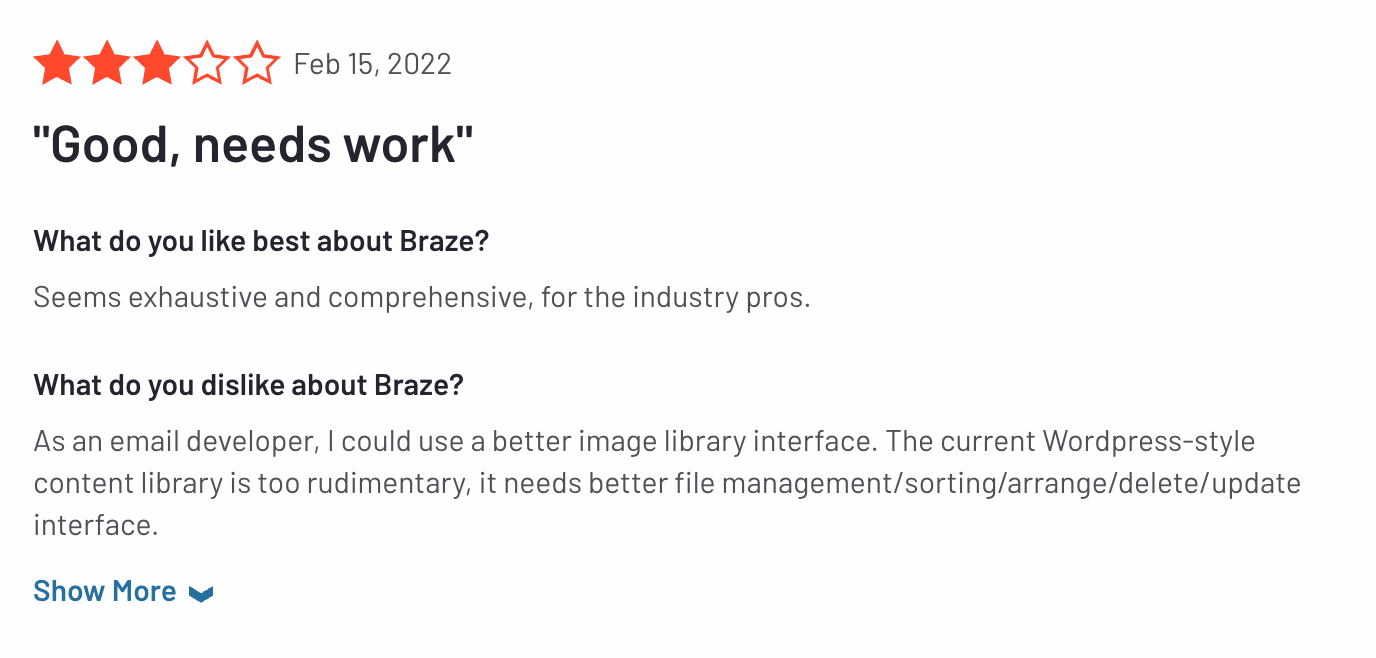
Compared to Bloomreach: Braze excels in mobile-centric real-time engagement and push notifications. Bloomreach remains stronger in integrated site search, content management, and product recommendations.
Compared to Maestra: Braze offers robust mobile marketing and real-time data triggers. Maestra, meanwhile, focuses on holistic retail experiences, featuring out-of-the-box loyalty and site personalization. Braze’s approach can require more developer work, whereas Maestra caters to non-technical marketers with built-in features.
Which Bloomreach Alternative Is Right For You
Ultimately, the best choice comes down to your priorities, budget, and team resources. If you need specialized site search and advanced merchandising, Bloomreach remains a robust contender despite its higher price.
For those wanting to consolidate multiple marketing tools in one place with strong support, platforms like Insider, Emarsys, and Klaviyo can each excel in specific areas—especially if you’re focused on mid-market needs.
Brands seeking enterprise-level capabilities without the overhead might look to Adobe or Salesforce, but must be prepared for hefty investments.
Meanwhile, Braze is ideal for mobile-first businesses aiming to engage users in real time.
Why Start with Maestra
Maestra stands out as an all-in-one solution that balances cost-effectiveness and powerful functionality. It includes advanced personalization, loyalty modules, real-time behavioral triggers, and integrations with major e-commerce platforms—wrapped in an intuitive interface that even smaller teams can manage with ease.
If you’re a mid-market or fast-growing retailer looking to elevate customer experiences without juggling multiple vendor contracts or draining internal resources, Maestra’s comprehensive approach is a compelling starting point. Book a demo right now!

